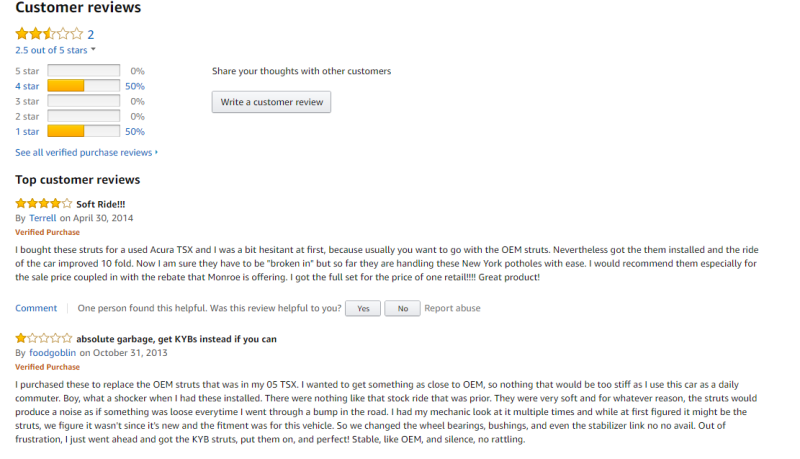I'm slowly sorting out what's wrong with the new suspension on my own car, which was replaced recently, with detrimental effect.
The shop is insisting that they have used the specified parts, and I insist that my Acura handles like a Buick now.
I've convinced the shop to keep the old suspension parts (removed at >300,000 km still working fine but leaking oil), and replace the (probably defective) replacements with another set. Now in the back of my mind is the idea of testing and measuring the load-stroke curve of the original parts and comparing with the supposedly-equivalent replacement parts. If these were aircraft Oleos, I would know what to do. Aircraft shock absorbers have an air chamber that resists displacements, and returns the shock to its original position. A force-displacement test is not hard to set up: a 5-ton press with a pressure gauge on the ram would give the force, a ruler would give the stroke. However, I don't believe this would be fruitful with an automobile shock. I doubt that I could do a "force-velocity" test as simply as a force-displacement test. Maybe I can... Is there a simple, practical test that I could do in my garage that would demonstrate that shock 1 is/is not equivalent to shock 2?
Are there aftermarket suspension makers that publish data for their shocks (I know Monroe doesn't)?
Is there any other way to deal with this, other than buy-it-try-it-too-bad?
STF
The shop is insisting that they have used the specified parts, and I insist that my Acura handles like a Buick now.
I've convinced the shop to keep the old suspension parts (removed at >300,000 km still working fine but leaking oil), and replace the (probably defective) replacements with another set. Now in the back of my mind is the idea of testing and measuring the load-stroke curve of the original parts and comparing with the supposedly-equivalent replacement parts. If these were aircraft Oleos, I would know what to do. Aircraft shock absorbers have an air chamber that resists displacements, and returns the shock to its original position. A force-displacement test is not hard to set up: a 5-ton press with a pressure gauge on the ram would give the force, a ruler would give the stroke. However, I don't believe this would be fruitful with an automobile shock. I doubt that I could do a "force-velocity" test as simply as a force-displacement test. Maybe I can... Is there a simple, practical test that I could do in my garage that would demonstrate that shock 1 is/is not equivalent to shock 2?
Are there aftermarket suspension makers that publish data for their shocks (I know Monroe doesn't)?
Is there any other way to deal with this, other than buy-it-try-it-too-bad?
STF


![[sadeyes] [sadeyes] [sadeyes]](/data/assets/smilies/sadeyes.gif) I really hate making choices when there is no factual information available.
I really hate making choices when there is no factual information available.